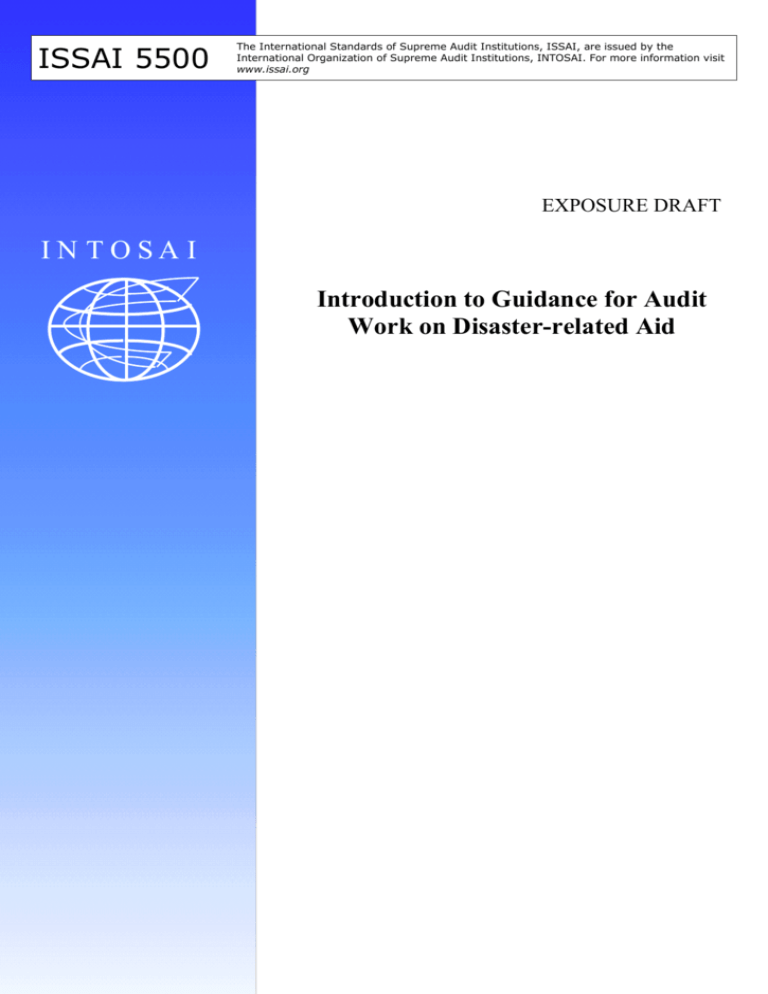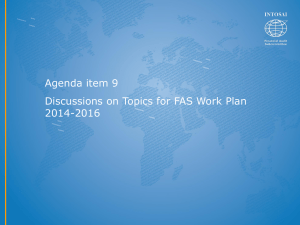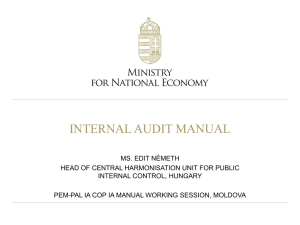ISSAI 5500: Auditing Disaster-Related Aid Guidance
advertisement

ISSAI 5500 The International Standards of Supreme Audit Institutions, ISSAI, are issued by the International Organization of Supreme Audit Institutions, INTOSAI. For more information visit www.issai.org EXPOSURE DRAFT I N T O SA I Introduction to Guidance for Audit Work on Disaster-related Aid INTO S AI Pr o f e s si o n a l S t an d ar ds Co m mitt e e PSC-Secretariat 2 Box 9009 • 1022 Copenhagen K • Denmark Rigsrevisionen • Store Kongensgade 45 • P.O. Tel.:+45 3392 8400 • Fax:+45 3311 0415 •E-mail: info@rigsrevisionen.dk I NTOS AI EXP ERIEN TIA MU TU A EXPERIEN TIA M UTUA OMN IBU S PRODEST OM NIBUS PRODEST INTOSAI General Secretariat - RECHNUNGSHOF (Austrian Court of Audit) DAMPFSCHIFFSTRASSE 2 A-1033 VIENNA AUSTRIA Tel.: ++43 (1) 711 71 • Fax: ++43 (1) 718 09 69 E-MAIL: intosai@rechnungshof.gv.at; WORLD WIDE WEB: http://www.intosai.org 3 Introduction to Guidance for Audit Work on Disaster-related Aid Table of contents 1. Auditing disasters 2. The 5500 series of ISSAIs 3. Disaster-related aid 4. Sources, types and phases of disaster-related aid 5. Characteristics of disaster-related aid of special interest to auditors 6. Using the ISSAIs 7. Content of ISSAIs 5510 to 5540 8. Accountability 9. IFAF: A tool for harmonised reporting APPPENDICES APPENDIX 1: The INTOSAI Working Group on Accountability for and the Audit of Disaster-related Aid APPENDIX 2: Members of the Working Group APPENDIX 3: Acknowledgements 4 Introduction to Guidance for Audit Work on Disaster-related Aid 1. Auditing disasters The United Nations reported 30,000 deaths and USD 366 billion of damage caused by 302 natural disasters in 2011. For the first twelve years of this century, disasters claimed 1.1 million lives and caused USD 1.3 trillion in economic damage. Governments react to disasters by donating humanitarian assistance to the victims of disasters. In 2010 they gave USD 12.4 billion. The Supreme Audit Institutions of the donating governments audit these funds as government expenditure. SAIs of countries affected by disasters audit humanitarian aid received from governmental and non-governmental donors, USD 16.7 billion in 2010, as well as the disasterrelated expenditure of their own governments. The growth in the frequency of disasters and in their human and economic impact over the past three decades has raised the profile of disaster-related aid for governments and their auditors. 2. The 5500 series of ISSAIs The 5500 series of ISSAIs provides guidance and best practice on the audit of disaster-related aid. The structure of the series is as follows: ISSAI 5500 – Introduction to guidance for audit work on disaster-related aid ISSAI 5510 – Audit of disaster preparedness ISSAI 5520 - Audit of disaster-related aid ISSAI 5530 - Adapting audit procedures to take account of the increased risk of fraud and corruption in the emergency phase following a disaster ISSAI 5540 - Use of geospatial information in auditing disaster management and disaster-related aid ISSAI 5500 contains background material on disaster-related aid, introduces and provides an overview of the ensuing guidance and indicates how best to use it. ISSAIs 5510 and 5520 cover the pre- and post-disaster phases. ISSAI 5530 considers the specific risks of fraud and corruption which arise due to the emergency nature of much of disaster-related aid. ISSAI 5540 presents a tool of special use for auditing disaster-related aid. Each ISSAI can be used as a source of information, containing examples of best practice or as guidance in its own right and can be read alone or in conjunction with the other ISSAIs on disaster-related aid. 3. Disaster-related aid Disaster-related aid falls within the broad category of humanitarian aid, which is designed to save lives, alleviate suffering and maintain and protect human dignity during and in the aftermath of emergencies. This may include developing disaster prevention and preparedness measures. Humanitarian aid and action differ in some respects from other forms of foreign assistance and development aid in that they are intended to be governed by the principles of humanity, neutrality, impartiality and independence and with the exception of disaster preparedness measures, are mainly short-term in nature. The ISSAIs on disaster-related aid focus on the humanitarian response to natural 5 disasters (earthquakes, tsunamis, landslides, floods, volcanic eruptions, etc.). However, the guidance can in principle also be applied to all of humanitarian aid, including that donated for and spent on man-made disasters or disasters which are the result of both natural and man-made hazards (famine, war, nuclear accidents, terrorist attacks, etc). 4. Sources, types and phases of disaster-related aid Governments, non-governmental organisations (NGOs), multilateral organisations, private foundations, trusts, private companies, corporations and individuals donate disaster-related assistance. Aid can be financial or provided in the form of goods and services donated in kind. It is donated to assist disaster-related activities, which may be in the immediate post-disaster emergency phase, the rehabilitation and reconstruction phase or for the purposes of disaster prevention and preparedness. The post-disaster emergency phase includes both the individual and local disaster response and the national and international emergency response: Rescue, recovery, first aid assistance, evacuation of the injured and burial of the dead; Emergency assistance and services (shelter, water, medicines etc.); Emergency food aid for immediate distribution and then for setting up feeding programmes); and Coordination of the relief and assistance actions, involvement of the military, protection of individuals and assuring support services, logistics and communications. The post-disaster rehabilitation and reconstruction phases include activities designed to restore basic services and functions and eventually establish levels of services to pre-disaster levels, or better. Disaster prevention and preparedness involve learning lessons from previous disasters and acting on them. They include disaster risk assessment, the installation of early warning systems, contingency stocks and planning for potential future disasters as well as educating people of the actions to take in the face of disaster to avoid and reduce their human and economic impact. 6 Figure 1 shows the link between the ISSAIs and the different phases of disaster-related aid. Post-disaster activities Pre-disaster activities Reconstruction -5520 -5540 Rehabilitation -5520 -5530 -5540 Emergency Response/ Relief -5520 -5530 -5540 Mitigation -5510 -5540 Preparedness -5510 -5540 Individual Disaster Response -5520 -5530 -5540 Figure 1: The ISSAIs and the phases of disaster-related aid 5. Characteristics of disaster-related aid of special interest to auditors Different risk factors affect the emergency and the non-emergency phases of the disaster-related aid cycle. The non-emergency phase comprises aid for less urgent rehabilitation and reconstruction measures as well as disaster prevention and preparedness activities. The circumstances under which this expenditure is made are normal and internal control systems can be expected to function normally. For donor SAIs the risk factors associated with the non-emergency phase should not differ significantly from those identified for development or other overseas aid. For SAIs in countries which are either affected by disaster or preparing for potential disaster, the risk profile of such expenditure may be similar to other government expenditure. What is specific to the emergency phase following disaster is the urgency of the action taken. Large amounts of aid arrive rapidly and must be managed and distributed quickly to save lives and limit losses. Internal control systems are often not in place or are not appropriately adapted to such activity. Emergency procedures are introduced and operational and procedural controls are frequently circumvented or simply ignored in the interest of speed. Auditors are faced with challenging additional risk factors in these situations. 7 6. Using the ISSAIs The 5500 series of ISSAIs reflects current best practice, includes illustrative examples, and proposes practical solutions for auditing disaster-related aid. The individual ISSAIs are closely related and cross referenced including to the guidance on general audit methodology and procedures in the third and fourth level ISSAIs, especially those on financial audit, performance audit and compliance audit. As is the case for other INTOSAI Auditing Standards, this guidance is not mandatory and each SAI should consider the extent to which the guidance is compatible with its mandate. The guidance builds upon INTOSAI’s Fundamental Auditing Principles and standards promulgated by other standard setting organisations with which INTOSAI has a cooperation agreement, such as the International Federation of Accountants. Depending on the structure of the public sector and the mandate of the SAI, the ISSAIs on disasterrelated aid can apply to audits at all levels of government: central, regional as well as local. Auditors of private entities such as NGOs receiving and managing public funds may also find the guidance applicable. Appendix 3 of ISSAI 5520 includes an example of specific guidance for private auditors of NGOs prepared by the SAI of Chile . 7. Content of ISSAIs 5510 to 5540 ISSAI 5510 recognises the increasing emphasis by governments and international organisations on reducing the risk of disasters and on reducing their potential impact through adequate preparation. The SAI of Turkey led the preparation of guidance for auditing disaster preparedness with assistance from the SAIs of Austria and Kenya. The SAI of Turkey gathered data from a number of INTOSAI members for a survey it carried out of experiences of auditing disaster preparedness. It also organised a parallel audit to collect input for the guidance. Thirty five SAIs replied to the survey and the SAIs of Azerbaijan, Chile, India, Indonesia, the Netherlands, Pakistan, the Philippines, Romania, Ukraine and Turkey contributed to or participated in the parallel audit. ISSAI 5520 takes account of the notable features of post-disaster activity, which include large amounts of resources flowing into disaster-affected areas, where there is pressure to deliver aid rapidly to individuals in great need. Aid may be disbursed by a number of different actors with varying levels of experience. There is often lack of coordination and inattention to the accountability and reporting of disaster-related aid, which renders the establishment of an audit trail difficult. The SAI of Indonesia took the lead in developing guidance for the audit of disaster-related aid, with assistance on subtopics from the SAIs of Chile and Peru. The SAI of Indonesia conducted two surveys and a parallel audit to gather data to feed into the guidance. This ISSAI focuses on the different phases and activities carried out in the aftermath of disasters, from the emergency phase through to rehabilitation and reconstruction. ISSAI 5530 reflects the recognition of the need for guidance on the higher risk of fraud and corruption in activities carried out during the initial weeks and months following a disaster. The SAI of the European Union therefore prepared guidance for auditors to consider the increased risk of fraud and corruption in the emergency phase of disaster-related aid. This guidance expands on ISSAI 1240 in broadening the scope to consider the risk of corruption as well as of fraud. It focuses on the 8 phase immediately following disasters, when procedures and controls might not function as they may normally be expected to do. To assist auditors, the guidance outlines risks and red flags of which auditors should be aware and provides advice on how to adapt audit procedures accordingly. ISSAI 5540 presents the use of appropriate tools employing modern technology for managers and auditors of disaster-related aid across the disaster management cycle. Assisted by experts in the field, the SAI of the Netherlands prepared guidance on the use of geospatial information and Geographical Information Systems (GIS) when auditing disaster-related aid. In addition to providing best practice and guidance on how to use geospatial information for auditing disaster-related aid, this ISSAI provides a comprehensive introduction to geospatial information and may therefore also be useful for SAIs conducting audits in areas not related to disasters or disaster-related aid. 8. Accountability The 5500 series of ISSAIs bears witness to the active role INTOSAI has adopted in encouraging its members to address the issue of auditing disaster-related aid. Closely related to this is the issue of better accountability for humanitarian aid to disaster-affected communities and to the taxpayer. Victims of disasters and donors of aid have in recent years demanded increasingly greater transparency and accountability over the administration and management of disaster-related aid. In many cases, Supreme Audit Institutions are well-positioned to promote accountability and transparency: through their audits, they can identify weaknesses in the existing arrangements and propose improvements to make disaster-related aid better reported, more accountable and more effective. In this context, SAIs have reported a need for improvements in the quality of financial reporting and in the availability of information on flows of disaster-related aid. For improved accountability and transparency of humanitarian aid SAIs found that it was necessary to obtain: A global view of the volume of aid which has gone into disasters, of who contributed aid and of where and on what it was spent; Consistently reliable and complete information concerning the individual flows of disasterrelated aid to allow an overall picture of the situation to be constructed and At the same time the reporting requirements for intermediary and implementing organisations should not constitute an untenable burden. 9. IFAF: A Tool for Harmonised Reporting Linked to the 5500 series of ISSAIs on disaster-related aid is an INTOSAI-GOV which presents a tool for harmonised reporting by the managers of disaster-related aid. The tool is called the Integrated Financial Accountability Framework (IFAF). It consists of tables which permit aid donors, international organisations, implementing organisations, auditors and other interested parties to obtain a complete picture of the flow of funds or relief activities for any given disaster as well as to follow individual aid payments down to the final recipient. The proposed tables are simple to prepare and understand, standardised, reliable and transparent; 9 Simplicity is derived from the fact that aid donors report their donations by listing the amount given to each organisation to which they have donated, and aid recipients report the corresponding amounts as receipts from each donor organisation. Payments are reported by operational activity unless they are made to an aid agency or other intermediary organisation passing on funds to other recipients, in which case the payments are reported by recipient; Standardisation is provided through the agreement of the majority of major donors and recipients to prepare the tables proposed; Reliability of the information is assured because the tables are drawn up from the same accounting system used for producing the organisations' financial statements and are subject to verification by the external auditor of the organisation concerned. Providing such audits are carried out on the basis of agreed standard guidelines, the potential exists for funds to be audited only once (auditors using the work of other auditors); Transparency is achieved by means of tables that are easy to read and made public alongside the other reports of each organisation. IFAF has been tested with different stakeholders in humanitarian aid: with donors, intermediary organisations and aid implementing organisations. These tests have been successful: organisations have found it easy to prepare IFAF tables using data already existing in their financial systems. More information about IFAF is provided in INTOSAI GOV XXXX. 10 APPENDIX 1 The INTOSAI Working Group on Accountability for and the Audit of Disaster-related Aid The interest of SAIs in accountability for and the audit of disaster-related aid has grown recent years due to the greater interest shown by donors (including taxpayers), the media and disaster victims in the use of disaster-related funds. Interest turned into action following the experience of SAIs after the disaster which occurred in South East Asia in 2004. On 26 December, the third biggest earthquake ever recorded struck off the west coast of Sumatra, Indonesia. It triggered a series of devastating tsunamis along the coasts of most landmasses bordering the Indian Ocean, killing over 230,000 people in fourteen countries, and inundating coastal communities with waves up to 30 meters high. It was one of the deadliest natural disasters in recorded history. Indonesia was the hardest hit country, followed by Sri Lanka, India, and Thailand. The plight of the affected people and countries prompted a worldwide humanitarian response. In all, the worldwide community donated more than USD14 billion in humanitarian aid. This vast amount of aid flowed from many different donors to many different recipients. Arrangements for the coordination and reporting of the aid were not in place. SAIs and other stakeholders assessed the situation and found that there was little information on aid flows and that it was difficult to establish an audit trail. In 2005, INTOSAI decided to contribute its collective auditing experience to the international community to enhance the accountability for and the transparency of disaster-related aid spending. The aim was to establish an overview of the tsunami-related aid flows based on the information provided by individual stakeholders (donors, international organisations, intermediary bodies and recipients) and to collaborate on the audit of the aid. In January 2005 – at the meeting of the INTOSAI Finance and Administration Committee – INTOSAI members discussed a potential INTOSAI initiative to enhance accountability over tsunami aid spending. The International Conference on Promoting Financial Accountability in Managing Funds Related to Tsunami, Conflict and Other Disasters took place in April 2005. The INTOSAI Governing Board established the INTOSAI Task Force on the Accountability and Audit of Emergency Aid in November 2005. The Task Force recommended that guidance should be prepared on best practice and on appropriate tools for the audit of disaster-related aid. INTOSAI accordingly set up the INTOSAI Working Group on Accountability for and the Audit of Disaster-related Aid at the XIX INCOSAI in Mexico in 2007. INCOSAI in 2007 gave the Working Group the following mandate: - To strive for enhanced accountability and transparency of disaster-related aid, in close cooperation with relevant stakeholders, by addressing the issue of the lack of a single information structure, and - To develop guidelines and best practices for SAIs auditing disaster-related aid. In 2010 the XX INCOSAI commended the work being undertaken and extended the mandate by asking the Working Group to examine the usefulness of its work for the whole of humanitarian aid. The Working Group translated the mandate it received into two objectives: - Objective A: the development of guidance and best practice for SAIs on the audit of disaster-related aid, covering the whole of the audit cycle: planning, executing and reporting; 11 - Objective B: the establishment of guidance and best practice regarding accountability for humanitarian aid. This includes the provision of a clear, transparent and standardised information tool for stakeholders (an integrated financial reporting framework). The involvement of important stakeholders (governments, international organisations and aid organisations) was seen as crucial for developing, testing, promoting and implementing this tool. These objectives were subdivided into separate tasks for which different Working Group members were responsible. Task 1 2 3 4 5 6 7 8 9 10 11 12 13 Description Responsible SAI (lead SAI underlined) Lessons learned from experiences with the International Aid Korea Transparency Initiative Harmonisation of accountability standards for aid ECA organisations: development of HAP Guide as a tool Harmonisation of accountability standards, ECA/Norway financial reporting/agreement on basic principles for financial reporting and promotion of single audit addressed to donors Auditing guidelines for private auditors of aid organisations Chile Introduction harmonised reporting and auditing in UN ECA Elaboration of guidance for auditing disaster-related aid Indonesia/Peru Organisation and coordination of a parallel audit and/or audit Indonesia feedback on disaster-related aid Elaboration of the guidance on auditing disaster preparedness Turkey/Austria/Kenya Organisation and coordination of a parallel audit and/or audit Turkey feedback on disaster preparedness Awareness of fraud and corruption during audits of disaster- ECA related aid Integration of the audit guidance documents into one and ECA possibility of ISSAI(s) Use of GIS as an audit tool The Netherlands Financial accountability information requirements USA 12 APPENDIX 2 Members of the Working Group Since it was established in 2008, the Working Group has had a membership of between 18 and 22 SAIs with a balance of representatives from donor and potential aid recipient countries and from a wide variety of geographical locations. Membership has remained fairly constant over the six years of the life of the Working Group. In May 2013, the following SAIs were members1: Austria, Chile, China, the European Court of Auditors, France, India, Indonesia, Jamaica, Japan, Kenya, Korea (Republic of), the Netherlands, Norway, Pakistan, Peru, the Philippines, Romania, Russian Federation, Sri Lanka, Turkey, the Ukraine2 and the United States of America. 1 Members include 5 of the top 10 donors and 2 of the top 10 recipients, according to the 2011 Global Humanitarian Assistance Report. 2 The audit of disaster-related aid has also been addressed by the EUROSAI Task Force on the audit of funds allocated to disasters and catastrophes, chaired by the SAI of the Ukraine. See http://www.ac-rada.gov.ua/control/eurosai/en/ 13 APPENDIX 3 Acknowledgements The INTOSAI Working Group on Accountability for and the Audit of Disaster-related Aid wishes to express its appreciation for the contributions made by INTOSAI members, especially those which prepared and contributed to the guidelines, those which participated in the parallel audits and those which replied to the surveys. The Working Group is also grateful for the valuable contributions made by other INTOSAI Working Groups and Committees and others, such as the Special Representative of the UN Secretary-General for Disaster Risk Reduction (UN ISDR), the Under Secretary-General of the UN Office for Internal Oversight Services, the European Commission, Transparency International, etc (to be completed) both for developing and improving the guidelines and for their input during meetings of the Working Group. See also the individual ISSAIs for further acknowledgements.







